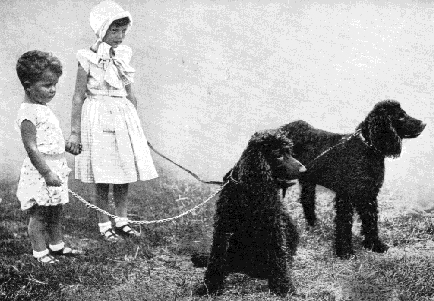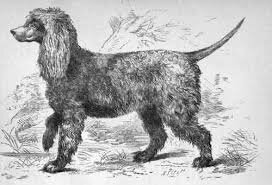Excerpts from British Dogs; Chapter XXIX, Hugh Dalziel, the Bazarr Office, London, 1897
“To a sportsman of limited means, the Irish water spaniel is the most useful dog he can have, inasmuch as he can be made to perform the duties of pointer, setter, retriever and spaniel; he is peculiarly fitted by temperament and by a water-resisting coat for the arduous duties required of wild fowl shooting. In this branch of sporting they have no equal, being able to stand any amount of hardship; this, combined with an indomitable spirit, leads them into deeds of daring from which many dogs would shrink. Many are the feats recorded of their pluck, sagacity, and intelligence. No sea is too rough, no pier too high, and no water too cold.
As a companion for a lady or gentleman they have no equal, whilst a well behaved dog of the breed is worth a whole mint of toys to the children, he allowing the little ones to pull him about by the ears, to roll over and over with them, to fetch their balls as often as thrown for him, and to act as their guard in times of danger.
The topknot is one of the chief characteristics of the breed; but I very much admire the topknot when about half grown, and when standing straight up all over the head in a most wild Irishman kind of manner. The face is long, and is the most remarkable feature of the breed to my mind, being in a good specimen quite smooth. The nose is large and it is the eye that gives character to the face; this should be a deep rich brown, which in the dark or shade is beautiful. The ears are long in the flesh, lobe shaped, and well furnished with hair. The chest should be deep and the ribs well sprung, so that the body appears round. The legs should be with good feet; heavily feathered, with a curled or rough appearance.
The tail is, like the face, a sure indication of the breeding; I assert that no other breed of dog exists with a smooth tail which carries as much hair elsewhere. The tail is shorter than in most other dogs, thick at the root, and tapering to a sting. The coat should consist of innumerable hard short curls, free from woolliness. The colour is that dark shade of liver called puce, having a rich plum-coloured hue. A patch of white is often seen on the chest, it is met with in the best strains.”





